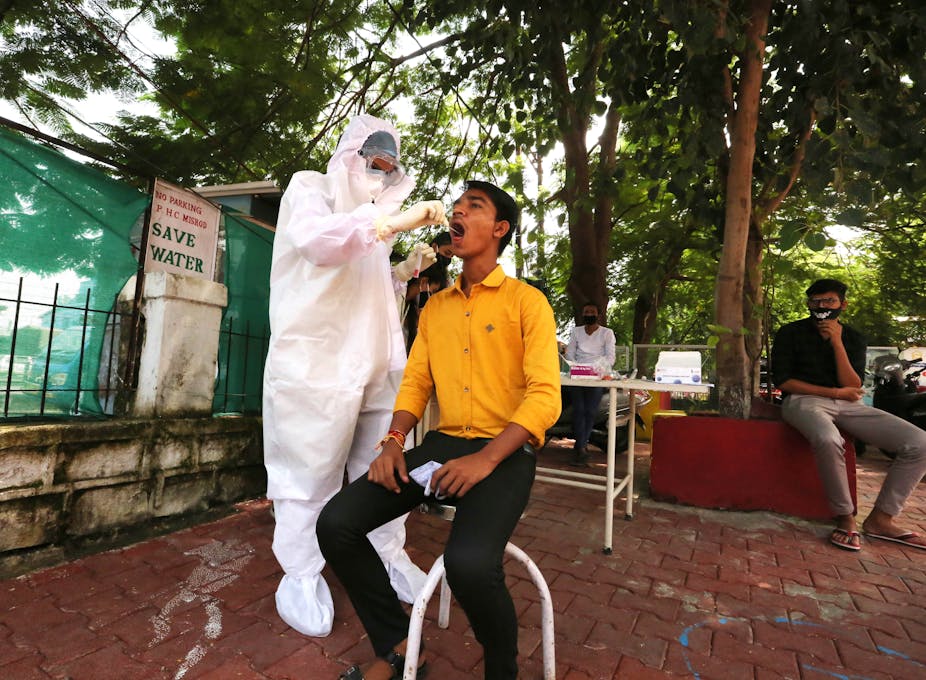South Asia accounted for nearly two-fifths of the world’s poor, nearly half of the world’s malnourished children and was home to the largest number of stunted children in 2015. Despite this, the region had made significant progress in lifting people out of poverty – and between 1990 and 2015 its poverty rate sharply declined from 52% to 17%.
Sustaining such progress in the region is key to achieving the global targets of the UN’s Sustainable Development Goals (SDGs) before 2030. But this trend could be reversed due to COVID-19. Globally, as many as 400 million people could be pushed into poverty by the pandemic. Restoring the pre-pandemic trend in poverty reduction in South Asia will be challenging, but not impossible.
During the era of the Millennium Development Goals (MDGs) between 1990 and 2015, South Asia’s achievements in reducing poverty and improving human development masked an uneven pattern of progress. There were significant differences in child mortality and income poverty reduction across the region – for example Bangladesh experienced exceptional improvements, while progress was limited in Pakistan and India. Yet there are important lessons from this era that can help accelerate future progress in post-pandemic South Asia.
50 more years?
In recently published research, we revisited South Asia’s development progress during the MDGs period. Our evidence confirms that, while South Asia caught up with richer regions in many important social indicators by 2015, progress was lacking in governance and state effectiveness. Given this shortfall, the past trends in human development are not sufficient to meet the 2030 development targets.
Our projections indicate that important milestones such as eradicating income poverty will not be achieved in South Asia by 2030. With a business as usual approach, it could take the region at least another 50 years from 2020 to eliminate poverty, meaning nobody in the region would be living on less than US$1.90 a day.

There are two key reasons behind these poor prospects. First, countries aren’t spending enough state resources on social development. In both education and health spending as a percentage of GDP, South Asia ranked even below Sub-Saharan Africa in 2015.
Second is the state’s limited effectiveness in delivering public services, such as health, education or administering policies aimed at reducing poverty. Both are important dimensions of state capacity – the ability of states to get things done – a measure on which South Asia lags behind other developing regions.
When thinking about how to reduce poverty, countries around the world typically rely on growing GDP – and, with it, people’s income. But the slowdown in macroeconomic growth caused by the pandemic limits the scope of this avenue for development.
Instead, governments in South Asia must spend money themselves to improve the delivery of services. Yet, the region not only suffers from large gaps in basic social infrastructure, South Asia’s tax-to-GDP ratio is also one of the lowest in the world. Not only are countries in the region poor at collecting tax, they’re also not well-equipped to spend what income they do raise effectively.
Getting things done
Our simulation confirms there would be a significant return on investment if South Asian governments spent money on improving the functioning of public services – for example making their tax systems more efficient, making sure there were more textbooks in local schools and vaccines available in local health services.
If government spending on education and health were to be raised alongside improvements in state capacity to levels witnessed in other developing regions such as Latin America or East Asia, South Asia would make significant progress in achieving the SDGs.

The crucial role of state capacity in achieving development has been brought into sharp relief by the way different countries have fared during the pandemic. Countries with high levels of state capacity have done relatively better in controlling the spread of the COVID-19 virus, as well as reducing the mortality rate. In both South Korea and Taiwan, for example, previous experience in addressing similar virus outbreaks, were important in controlling the spread of the disease and keeping fatality rates low.
In South Asia, the Indian state of Kerala has had relatively high success in controlling the spread of the virus among Indian states. This has been credited to extensive past state investment in public health and a cadre of committed local government officials who were swiftly able to put in place World Health Organization protocols of test, trace, isolate and support.
Our hope is that the emergency of the pandemic itself could help create the conditions to develop effective state institutions or to improve existing ones in South Asia. This could be more likely as the interest of both ruling elites and citizens are likely to be aligned when there is a common threat to prosperity.

